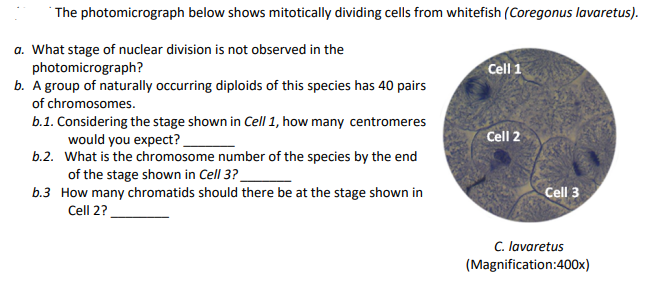The photomicrograph below shows mitotically dividing cells from whitefish (Coregonus lavaretus). a. What stage of nuclear division is not observed in the Cell 1 photomicrograph? b. A group of naturally occurring diploids of this species has 40 pairs of chromosomes. b.1. Considering the stage shown in Cell 1, how many centromeres would you expect? b.2. What is the chromosome number of the species by the end Cell 2 of the stage shown in Cell 3?_ b.3 How many chromatids should there be at the stage shown in Cell 3 Cell 2? C. lavaretus (Magnification:400x)
The photomicrograph below shows mitotically dividing cells from whitefish (Coregonus lavaretus). a. What stage of nuclear division is not observed in the Cell 1 photomicrograph? b. A group of naturally occurring diploids of this species has 40 pairs of chromosomes. b.1. Considering the stage shown in Cell 1, how many centromeres would you expect? b.2. What is the chromosome number of the species by the end Cell 2 of the stage shown in Cell 3?_ b.3 How many chromatids should there be at the stage shown in Cell 3 Cell 2? C. lavaretus (Magnification:400x)
Human Heredity: Principles and Issues (MindTap Course List)
11th Edition
ISBN:9781305251052
Author:Michael Cummings
Publisher:Michael Cummings
Chapter6: Cytogenetics: Karyotypes And Chromosome Aberrations
Section: Chapter Questions
Problem 14QP: Variations in Chromosome NumberAneuploidy Describe the process of nondisjunction and explain when it...
Related questions
Topic Video
Question
1

Transcribed Image Text:The photomicrograph below shows mitotically dividing cells from whitefish (Coregonus lavaretus).
a. What stage of nuclear division is not observed in the
Cell 1
photomicrograph?
b. A group of naturally occurring diploids of this species has 40 pairs
of chromosomes.
b.1. Considering the stage shown in Cell 1, how many centromeres
would you expect?
b.2. What is the chromosome number of the species by the end
Cell 2
of the stage shown in Cell 3?_
b.3 How many chromatids should there be at the stage shown in
Cell 3
Cell 2?
C. lavaretus
(Magnification:400x)
Expert Solution
This question has been solved!
Explore an expertly crafted, step-by-step solution for a thorough understanding of key concepts.
This is a popular solution!
Trending now
This is a popular solution!
Step by step
Solved in 2 steps with 1 images

Knowledge Booster
Learn more about
Need a deep-dive on the concept behind this application? Look no further. Learn more about this topic, biology and related others by exploring similar questions and additional content below.Recommended textbooks for you

Human Heredity: Principles and Issues (MindTap Co…
Biology
ISBN:
9781305251052
Author:
Michael Cummings
Publisher:
Cengage Learning

Human Heredity: Principles and Issues (MindTap Co…
Biology
ISBN:
9781305251052
Author:
Michael Cummings
Publisher:
Cengage Learning